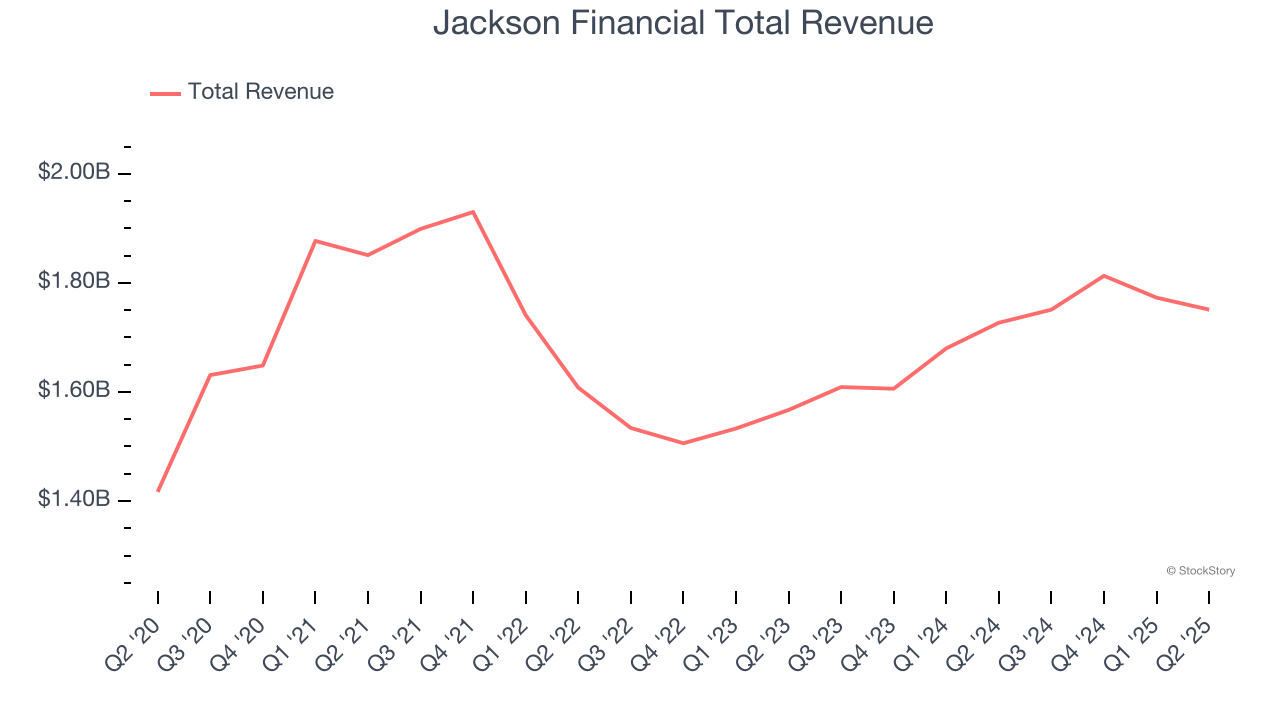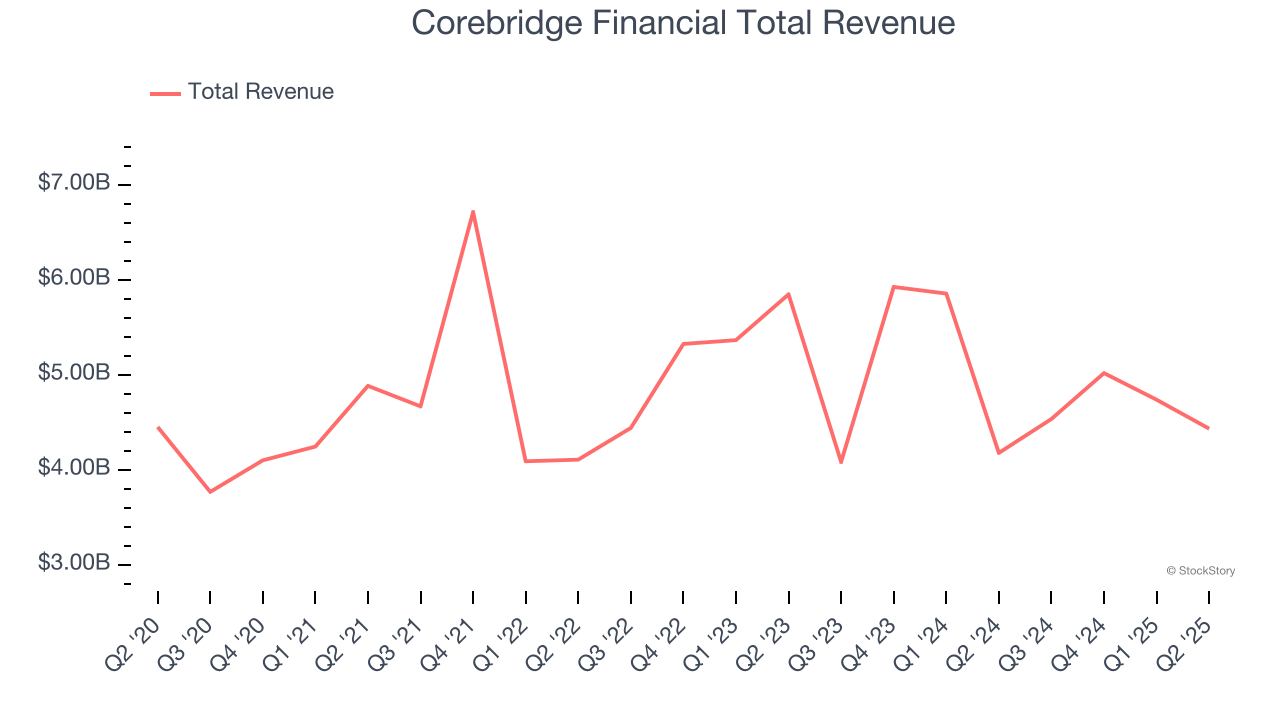
The end of an earnings season can be a great time to discover new stocks and assess how companies are handling the current business environment. Let’s take a look at how Jackson Financial (NYSE:JXN) and the rest of the life insurance stocks fared in Q2.
Life insurance companies collect premiums from policyholders in exchange for providing a future death benefit or retirement income stream. Interest rates matter for the sector (and make it cyclical), with higher rates allowing insurers to reinvest their fixed-income portfolios at more attractive yields and vice versa. Additionally, favorable demographic shifts, such as an aging population, are driving strong demand for retirement products while AI and data analytics offer significant opportunities to improve underwriting accuracy and operational efficiency. Conversely, the industry faces headwinds from persistent competition from agile insurtechs that threaten traditional distribution models.
The 15 life insurance stocks we track reported a slower Q2. As a group, revenues were in line with analysts’ consensus estimates.
Thankfully, share prices of the companies have been resilient as they are up 5.1% on average since the latest earnings results.
Jackson Financial (NYSE:JXN)
Spun off from British insurer Prudential plc in 2021 after more than 60 years as its U.S. subsidiary, Jackson Financial (NYSE:JXN) offers annuity products and retirement solutions that help Americans grow and protect their retirement savings and income.
Jackson Financial reported revenues of $1.75 billion, up 1.4% year on year. This print was in line with analysts’ expectations, but overall, it was a mixed quarter for the company.
Laura Prieskorn, President and Chief Executive Officer of Jackson, stated, “Our second quarter results underscore the continued strength of our business and our steady progress toward achieving strategic objectives. We delivered another quarter of year-over-year growth in retail annuity sales, driven by our well-diversified product portfolio which now includes our recently launched Jackson Market Link Pro® III and Jackson Market Link Pro Advisory® III. Our robust in-force book generated free cash flow of $290 million for the quarter—significantly surpassing the $229 million generated during the second quarter of 2024—and exceeded $1 billion over the twelve months ended June 30, 2025. We also returned $216 million to common shareholders, maintained an estimated RBC ratio well above our target, and further strengthened our already substantial excess cash position at the holding company. We are confident in our ability to sustain this positive momentum throughout 2025 as we continue to help Americans secure their financial futures.”

Interestingly, the stock is up 11.5% since reporting and currently trades at $96.47.
Is now the time to buy Jackson Financial? Access our full analysis of the earnings results here, it’s free.
Best Q2: Corebridge Financial (NYSE:CRBG)
Spun off from insurance giant AIG in 2022 to focus on the growing retirement market, Corebridge Financial (NYSE:CRBG) provides retirement solutions, annuities, life insurance, and institutional risk management products in the United States.
Corebridge Financial reported revenues of $4.43 billion, up 6.1% year on year, outperforming analysts’ expectations by 7.6%. The business had a stunning quarter with a beat of analysts’ EPS estimates.

Although it had a fine quarter compared its peers, the market seems unhappy with the results as the stock is down 4% since reporting. It currently trades at $33.39.
Is now the time to buy Corebridge Financial? Access our full analysis of the earnings results here, it’s free.
Weakest Q2: Equitable Holdings (NYSE:EQH)
Tracing its roots back to 1859 as one of America's oldest financial institutions, Equitable Holdings (NYSE:EQH) provides retirement planning, asset management, and life insurance products through its two main franchises, Equitable and AllianceBernstein.
Equitable Holdings reported revenues of $3.80 billion, up 5.1% year on year, falling short of analysts’ expectations by 4.5%. It was a disappointing quarter as it posted a significant miss of analysts’ EPS estimates.
Interestingly, the stock is up 3.5% since the results and currently trades at $52.69.
Read our full analysis of Equitable Holdings’s results here.
Prudential (NYSE:PRU)
Recognized by its iconic Rock of Gibraltar logo symbolizing strength and stability since 1896, Prudential Financial (NYSE:PRU) provides life insurance, annuities, retirement solutions, investment management, and other financial services to individual and institutional customers globally.
Prudential reported revenues of $13.51 billion, down 2.5% year on year. This number lagged analysts' expectations by 1%. Taking a step back, it was a mixed quarter as it also produced an impressive beat of analysts’ net premiums earned estimates but a significant miss of analysts’ book value per share estimates.
The stock is up 3.1% since reporting and currently trades at $105.
Read our full, actionable report on Prudential here, it’s free.
MetLife (NYSE:MET)
Founded in 1863 by a group of New York businessmen during the Civil War era, MetLife (NYSE:MET) is a global financial services company that provides insurance, annuities, employee benefits, and asset management services to individuals and businesses worldwide.
MetLife reported revenues of $17.92 billion, down 4.1% year on year. This print came in 3.9% below analysts' expectations. It was a softer quarter as it also recorded a significant miss of analysts’ book value per share estimates and a significant miss of analysts’ EPS estimates.
The stock is up 4.1% since reporting and currently trades at $79.13.
Read our full, actionable report on MetLife here, it’s free.
Market Update
As a result of the Fed’s rate hikes in 2022 and 2023, inflation has come down from frothy levels post-pandemic. The general rise in the price of goods and services is trending towards the Fed’s 2% goal as of late, which is good news. The higher rates that fought inflation also didn't slow economic activity enough to catalyze a recession. So far, soft landing. This, combined with recent rate cuts (half a percent in September 2024 and a quarter percent in November 2024) have led to strong stock market performance in 2024. The icing on the cake for 2024 returns was Donald Trump’s victory in the U.S. Presidential Election in early November, sending major indices to all-time highs in the week following the election. Still, debates around the health of the economy and the impact of potential tariffs and corporate tax cuts remain, leaving much uncertainty around 2025.
Want to invest in winners with rock-solid fundamentals? Check out our Strong Momentum Stocks and add them to your watchlist. These companies are poised for growth regardless of the political or macroeconomic climate.
StockStory is growing and hiring equity analyst and marketing roles. Are you a 0 to 1 builder passionate about the markets and AI? See the open roles here.
